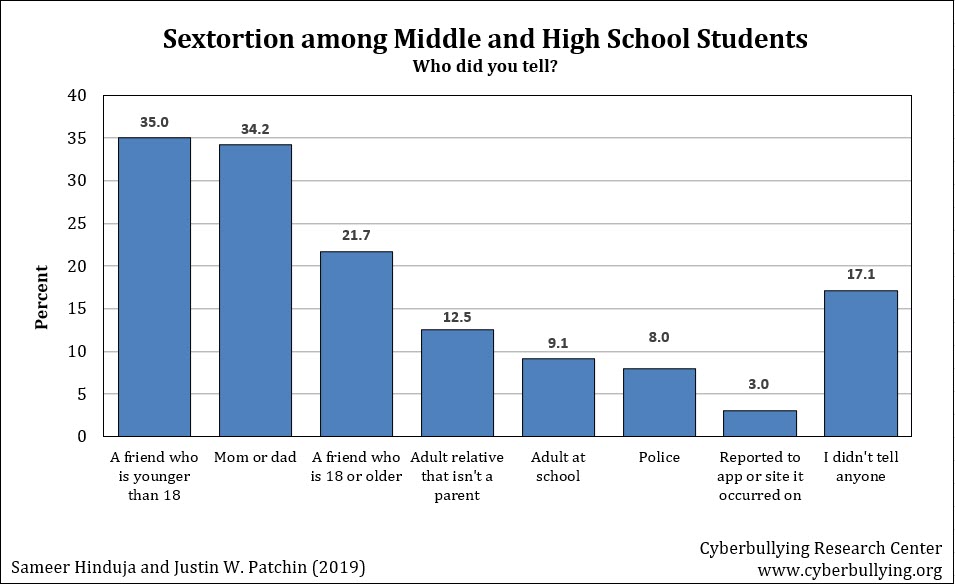
Earlier this year, thirty-six-year old Barton Scott hacked into dozens of Snapchat accounts to access explicit images of 14 to 16 year-old girls. According to court records, he manipulated and subsequently coerced victims into turning over their passwords, giving him access to images not intended for public dissemination. He then used those private images as leverage to pressure teens into sending more nude photos and videos.
This is just one recent example of sextortion, which we have formally defined as “the threatened dissemination of explicit, intimate, or embarrassing images of a sexual nature without consent, usually for the purpose of procuring additional images, sexual acts, money, or something else.” Sextortion can occur when explicit images are voluntarily provided to others (e.g., beginning as consensual sexting), or when they are accessed without permission (e.g., hacking a device or account). Once in possession of these sensitive images, offenders demand more. They threaten to disclose the images to others–usually family or friends–unless more images, videos, money, or something else is given.
Sextortion Research
Despite widespread public concern about sextortion over the last several years, there has been very little research systematically examining it. Last year we published the first academic article that explored sextortion among middle and high school students. Other scholars have previously reviewed court records of sextortion cases or surveyed adults about their experience with these behaviors, but ours was the first study to survey adolescents about their personal experiences. We wanted to know more about the nature of sextortion incidents, who was experiencing it, and how big of a problem it was.
We collected some important baseline data in that study, which was based on a national U.S. sample of about 5,500 students collected in 2016. Results showed that about 5% of students had been the target of sextortion and that about 3% had done it to others. We also learned that most youth who are targeted do not tell adults about what happened (only about 40% reported the incident to an adult, with girls significantly more like to do so than boys). You can read more about that study here.
As important as that first study was, many additional questions remained. So, we set out to answer a few of them in our most recent survey, with data collected in April of this year from about 5,000 middle and high school students. About the same number of youth were the target of sextortion in 2019 (5.3%) as 2016. We also found a similar prevalence rate for those who admitted to us that they had threatened others with sextortion (3.4%). In both surveys, males were more likely to be involved in sextortion both as a target and as an aggressor. This is noteworthy because most of the public discussion of sextortion involves female victims (an incident earlier this year involving Jeff Bezos–Founder and CEO of Amazon–being a high profile exception).
About the same number of youth were the target of sextortion in 2019 (5.3%) as 2016 (5.0%).
To learn more details about the nature of sextortion incidents, we asked those who had been targeted to tell us what the person threatened to do to them, and ultimately what they actually did. Forty-three percent of those who experienced sextortion said the aggressor threatened to send the explicit image to the victim’s friends, while 35% said they would post the photo online and 29% said they would tell the target’s parents. When it came to what the aggressor actually did, about one in five said their photo was sent to their friends, and about the same number said their photo was posted online. Thirty-eight percent of the time, the aggressor ended up doing nothing (as far as they knew).
Most of the time the aggressor wanted more photos (38%), sex or a sexual act (29%), or money (29%). About half the time the target did not comply with the requests, but 23% sent more photos; 19% sent money; and 18% provided sex or a sex act.

The proportion of youth who experienced sextortion who told an adult (parent, educator, police officer) increased only slightly from 2016 to 2019 (from 39.9% to 41.1%). Most often, victims tell friends, but about 17% did not tell anyone. Clearly more needs to be done to encourage victims to come forward about their experience.

Additional Research Questions
One question we did not ask is how the perpetrator came to acquire the explicit images in the first place. Barton Scott apparently befriended, groomed, and ultimately manipulated victims into sharing their Snapchat passwords. I’m not entirely clear how he used access to the accounts to access the images (maybe the Snapchat access created access to the user’s camera roll, where images were stored), but it appears that the targets did not initially send explicit images to him freely.
Presumably a large portion of most victims of sextortion do provide their images to others voluntarily. That is, consensual sexting turns into exploitative sextortion. In our data, 75% of the victims of sextortion admitted to sending a sexually-explicit image of themselves to someone else. That means that at least 25% of the victims did not, and their images were somehow procured illicitly (perhaps through hacking their phone, or the Cloud where their images were backed up). Future research should better understand how offenders come to possess the images in the first place, as this might help inform prevention efforts. Certainly refraining from taking explicit photos of one’s self would help (though not completely prevent it from happening as someone could still covertly take a photo of another).
Boys are more likely to be the target of sextortion, but less likely to report it to an adult.
Moreover, research should seek to better understand how the sextortion experiences of boys and girls differ. Our data suggest that boys are more likely to be the target of sextortion, but are less likely to report it to an adult. Why are boys less likely to come forward? We know that middle and high school boys are significantly more likely to have sent a sext to someone else (16.4% compared to 12.2%), possibly opening themselves up to vulnerability for sextortion. Maybe they are reluctant to report because they initially shared the images voluntarily and don’t want to risk being labeled a distributor of child pornography. We also know that boys are more likely to have been threatened by a boyfriend/girlfriend (48% compared to 41%) while girls are more likely to have been threatened by a stranger (6% compared to 3%). It might be easier to seek help when the aggressor is a stranger than when it is someone known to the target (especially a current or former romantic partner).
Finally, even though we have now surveyed over 10,000 middle and high school students in the last three years, we only have data from about 500 in that sample who have experienced sextortion. It is difficult to understand the unique characteristics of these behaviors with such a small sub-sample. More data, from more who have been involved in sextortion incidents, would enable researchers to learn even more about these behaviors, particularly among unique populations of youth (LGBTQ, racial minorities, etc.).
Responding to Sextortion
Barton Scott is a predator. He was sentenced in September to 25 years in prison. If the results of our 2019 research are accurate, he is an anomaly to the extent that it was an adult targeting unknown minors. In our study, nearly half of those who were targeted (44.9%) said the person threatening them was a boyfriend or girlfriend. About two-thirds of the time, the person was approximately the same age as the target. It is actually quite rare for the aggressor to be over the age of 18 (less than 5% of the time in our data). That said, anytime anyone–of any age–is threatening another person, using sensitive images as a weapon to force compliance to demands, it should be investigated as criminal behavior. These incidents do require thoughtful consideration of all of the elements involved (relationship between individuals, nature of threats made, how widespread the images have been circulated, harm to target, etc.) to determine the most appropriate response.
We must create safe opportunities for those who are being exploited to report by ensuring a rational response that takes their developmental maturity into consideration.
Finally, the FBI believes that there are more victims who have yet to come forward in Barton Scott’s case. The pressure to conceal these behaviors is high given the potentially significant consequences for youth who share explicit images. This is unfortunate, because if youth hesitate to let someone know that they are being sextorted because they don’t want to be blamed or punished for taking and sending a nude in the first place, it gives aggressors the upper-hand for further control and manipulation. We must create safe opportunities for those who are being exploited to report by ensuring a rational response that takes their developmental maturity into consideration. Adolescents, by there nature, are prone to experimenting with their sexuality (and in their relationships) in ways that could result in them being taken advantage of. In short, youth who voluntarily share images with others, and then who are subsequently targeted for sextortion, should be treated and supported as victims, rather than labeled and prosecuted as distributors of child pornography. Legislators might even consider passing immunity laws, protecting youth who sext from prosecution when they are being extorted.
In conclusion, we’ve made some good progress on better understanding the nature and extent of sextortion among adolescents. But there is still a lot of work left to do. We’ll continue to study these behaviors and encourage you to do whatever you can to contribute to a society where victims are supported and predators are held accountable.
Suggested citation: Patchin, J. W. (2019). Sextortion: More Insight Into the Experiences of Youth. Cyberbullying Research Center. https://cyberbullying.org/sextortion-more-insight-into-the-experiences-of-youth
Image: Boudewijn Huysmans (unsplash)
Support for this study was provided by a grant from Facebook Research







